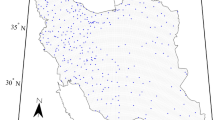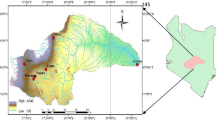Abstract
On 20 July 2021, a sudden rainstorm happened in central and northern Henan Province, China, killing at least 302 people. This extreme precipitation event incurred substantial socioeconomic impacts and resulted in serious losses. Accurate monitoring of such rainstorm events is crucial. In this study, qualitative and quantitative methods are used to comprehensively evaluate the abilities of 10 high-resolution satellite precipitation products [CMORPH-Raw (Climate Prediction Center morphing technique), CMORPH-RT, PERSIANN-CCS (Precipitation Estimation from Remotely Sensed Information Using Artificial Neural Networks), GPM IMERG-Early (Integrated Multisatellite Retrievals for Global Precipitation Measurement), GPM IMERG-Late, GSMaP-Now (Global Satellite Map** of Precipitation), GSMaP-NRT, FY-2F, FY-2G, and FY-2H] in capturing this extreme rainstorm event, as well as their performances in monitoring different precipitation intensities. The results show that these satellite precipitation products are able to capture the spatial distributions of the rainstorm (e.g., its location in central and northern Henan), but all products have underestimated the amount of precipitation in the rainstorm center. With the increase in precipitation intensity, the hit rate decreases, the threat score decreases, and the false alarm rate increases. CMORPH-RT is better at capturing the rainstorm than CMORPH-Raw, and it depictes the rainstorm process well; GPM IMERG-Late is more accurate than GPM IMERG-Early; GSMaP-NRT has performed better than GSMaP-Now; and PERSIANN-CCS and FY-2F perform poorly. Among the products, CMORPH-RT performs the best, which has accurately captured the center of the rainstorm, and is also the closest to the station-based observations. In general, the satellite precipitation products that integrate infrared and passive microwave data are found to be better than those that only make use of infrared data. The satellite precipitation retrieval algorithm and the amount of passive microwave data have a relatively greater impact on the accuracy of satellite precipitation products.
Similar content being viewed by others
References
Abdourahamane, Z. S., 2021: Evaluation of fine resolution gridded rainfall datasets over a dense network of rain gauges in Niger. Atmos. Res., 252, 105459, doi: https://doi.org/10.1016/j.atmosres.2021.105459.
Cressman, G. P., 1959: An operational objective analysis system. Mon. Wea. Rev., 87, 367–374, doi: https://doi.org/10.1175/1520-0493(1959)087<0367:AOOAS>2.0.CO;2.
Gao, Y., H. Xu, and G. Liu, 2019: Evaluation of the GSMaP estimates on monitoring extreme precipitation events. Remote Sens. Technol. Appl., 34, 1121–1132. (in Chinese)
Gourley, J. J., Y. Hong, Z. L. Flamig, et al., 2011: Hydrologic evaluation of rainfall estimates from radar, satellite, gauge, and combinations on Ft. Cobb basin, Oklahoma. J. Hydrometeor., 12, 973–988, doi: https://doi.org/10.1175/2011JHM1287.1.
He, S. S., J. Wang, and H. J. Wang, 2018: Hindcast study of “6.18” Mentougou debris-flow event based on satellite rainfall and WRF forecasted rainfall. Chinese J. Atmos. Sci., 42, 590–606, doi: https://doi.org/10.3878/j.issn.1009-9895.1804.18148. (in Chinese)
Hong, Y., K.-L. Hsu, S. Sorooshian, et al., 2004: Precipitation estimation from remotely sensed imagery using an artificial neural network cloud classification system. J. Appl. Meteor. Climatol., 43, 1834–1853, doi: https://doi.org/10.1175/JAM2173.1.
Huang, Y., S. Chen, Q. Cao, et al., 2014: Evaluation of Version-7 TRMM multi-satellite precipitation analysis product during the Bei**g extreme heavy rainfall event of 21 July 2012. Water, 6, 32–44, doi: https://doi.org/10.3390/w6010032.
Huffman, G. J., R. F. Adler, D. T. Bolvin, et al., 2007: The TRMM multisatellite precipitation analysis (TMPA): Quasi-global, multiyear, combined-sensor precipitation estimates at fine scales. J. Hydrometeor., 8, 38–55, doi: https://doi.org/10.1175/JHM560.1.
IPCC, 2021: Climate Change 2021: The Physical Science Basis. Contribution of Working Group I to the Sixth Assessment Report of the Intergovernmental Panel on Climate Change, V. Masson-Delmotte, P. Zhai, A. Pirani, et al., Eds., Cambridge University Press, Cambridge, United Kingdom and New York, NY, USA, 3949 pp.
Jiang, S. H., S. Y. Liu, L. L. Ren, et al., 2018: Hydrologic evaluation of six high resolution satellite precipitation products in capturing extreme precipitation and streamflow over a medium-sized basin in China. Water, 10, 25, doi: https://doi.org/10.3390/w10010025.
Joyce, R. J., J. E. Janowiak, P. A. Arkin, et al., 2004: CMORPH: A method that produces global precipitation estimates from passive microwave and infrared data at high spatial and temporal resolution. J. Hydrometeor., 5, 487–503, doi: https://doi.org/10.1175/1525-7541(2004)005<0487:CAMTPG>2.0.CO;2.
Kidd, C., and V. Levizzani, 2011: Status of satellite precipitation retrievals. Hydrol. Earth Syst. Sci., 15, 1109–1116, doi: https://doi.org/10.5194/hess-15-1109-2011.
Li, Q. L., W. C. Zhang, L. Yi, et al., 2018: Accuracy evaluation and comparison of GPM and TRMM precipitation product over Mainland China. Adv. Water Sci., 29, 303–313, doi: https://doi.org/10.14042/j.cnki.32.1309.2018.03.001. (in Chinese)
Li, Z., D. Yang, and Y. Hong, 2012: The opportunities and challenges: Statistical and hydrological evaluation of high-resolution multisensor blended global precipitation products over the Yangtze River Basin, China. American Geophysical Union Fall Meeting Abstracts, AGU, Washington, H33C-1328.
Okamoto, K., T. Ushio, T. Iguchi, et al., 2005: The Global Satellite Map** of Precipitation (GSMaP) project. 2005 IEEE International Geoscience and Remote Sensing Symposium, IEEE, Seoul, 3414–3416, doi: https://doi.org/10.1109/HGARSS.2005.5226575.
Sorooshian, S., A. AghaKouchak, P. Arkin, et al., 2011: Advanced concepts on remote sensing of precipitation at multiple scales. Bull. Amer. Meteor. Soc., 92, 1353–1357, doi: https://doi.org/10.1175/2011BAMS3158.1.
Tang, G. Q., M. P. Clark, S. M. Papalexiou, et al., 2020: Have satellite precipitation products improved over last two decades? A comprehensive comparison of GPM IMERG with nine satellite and reanalysis datasets. Remote Sens. Environ., 240, 111697, doi: https://doi.org/10.1016/j.rse.2020.111697.
Wang, J., H.-J. Wang, and Y. Hong, 2016: Comparison of satellite-estimated and model-forecasted rainfall data during a deadly debris-flow event in Zhouqu, Northwest China. Atmos. Ocean. Sci. Lett., 9, 139–145, doi: https://doi.org/10.1080/16742834.2016.1142825.
Wang, R., J. Y. Chen, and X. W. Wang, 2017: Comparison of IMERG level-3 and TMPA 3B42V7 in estimating typhoon-related heavy rain. Water, 9, 276, doi: https://doi.org/10.3390/w9040276.
Zeng, Q. L., Y. Q. Wang, L. F. Chen, et al., 2018: Inter-comparison and evaluation of remote sensing precipitation products over China from 2005 to 2013. Remote Sens., 10, 168, doi: https://doi.org/10.3390/rs10020168.
Zhang, L. L., Y. Kang, Q. H. Yue, et al., 2021: Analysis of the applicability of various satellite-based precipitation in the source region of Yellow River. Yellow River, 43, 29–33, doi: https://doi.org/10.3969/j.issn.1000-1379.2021.03.006. (in Chinese)
Zhao, H. G., S. T. Yang, S. C. You, et al., 2018: Comprehensive evaluation of two successive V3 and V4 IMERG Final Run precipitation products over Mainland China. Remote Sens., 10, 34, doi: https://doi.org/10.3390/rs10010034.
Zhou, T. J., R. C. Yu, H. M. Chen, et al., 2008: Summer precipitation frequency, intensity, and diurnal cycle over China: A comparison of satellite data with rain gauge observations. J. Climate, 21, 3997–4010, doi: https://doi.org/10.1175/2008JCLI2028.1.
Author information
Authors and Affiliations
Corresponding author
Additional information
Supported by the National Natural Science Foundation of China (41991283 and 42175170).
Electronic Supplementary Material
Rights and permissions
About this article
Cite this article
Liu, S., Wang, J. & Wang, H. Assessing 10 Satellite Precipitation Products in Capturing the July 2021 Extreme Heavy Rain in Henan, China. J Meteorol Res 36, 798–808 (2022). https://doi.org/10.1007/s13351-022-2053-y
Received:
Accepted:
Published:
Issue Date:
DOI: https://doi.org/10.1007/s13351-022-2053-y




